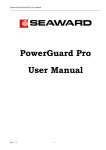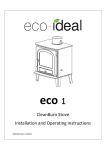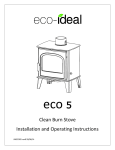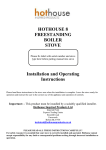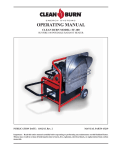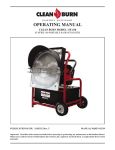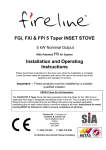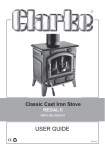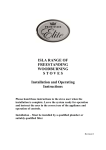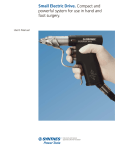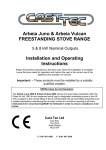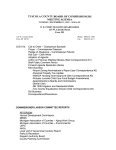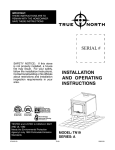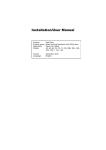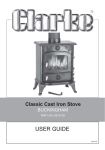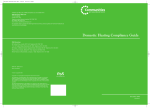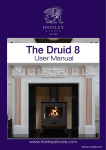Download the user manual
Transcript
N Ø R R E S K O V E N M U L T I F U E L S T O V E Installation and Operating Instructions An accredited competent person must carry out the installation of this appliance; alternatively, your local Building Control Officer can approve the completed installation, should a non-accredited engineer undertake the installation. It is an offence, under UK law, not to comply with this advice. Please hand these instructions to the stove user when the installation is complete. Leave the system ready for operation and instruct the user in the correct use of the appliance and operation of controls. v03.10 Nørreskoven Technical Specification Stove Mass 100 kg DS/EN 13240 Total Efficiency Nominal Heat Output Mean CO Emission (at 13% O2) Mean OGC Emission (at 13% O2) Mean Flue Gas Temperature Flue Gas Mass Flow 82.0 % 4.9 kW 0.10 % 96 mg/nm3 220 °C 4.7 g/s (Figures based on a fuel load of 1.4 kg wood logs with primary air closed and secondary air 50% open) NS 3058/59 Average particulate emission Maximum particulate emission 3.27 g/kg 3.49 g/kg This appliance is not suitable for use in a shared flue This appliance is suitable for intermittent burning Assembly Instructions PLEASE READ THESE INSTRUCTIONS CAREFULLY It is important that your stove is correctly installed, as Cleanburn Stoves cannot accept responsibility for any fault arising through incorrect use or installation. Flue Collar Wind the eight M6 studs supplied into the fixing holes in the flue collar and blanking plate until finger tight. Place the gasket in position on the top plate of the stove and lower the flue collar or blanking plate (as required) on to the stove top, taking care to line up the studs with the fixing holes. Secure in place using the M6 nuts and washers. Fit the two M8 coach bolts in the flue collar to blank off the optional damper handle holes. Blanking Plate Fit the Flue Gasket and Blanking Plate on the remaining free outlet and secure it, using the two M6 studs. Removing Internal Parts This set of instructions explains the removal sequence that you will need to employ when servicing your Cleanburn stove. 1. Open the stove door(s) and remove the ash pan. 2. Remove the baffle by pulling it forwards and sliding it to the left until the right side of it clears the baffle support and then lowering it into the firebox and removing it (a). 3. Remove the grate bars by lifting them out in pairs (b). (b) (a) 4. Remove the side bricks by lifting them up and swinging the bottom end towards the centre of the stove (c). 5. Remove the rear brick (d). (c) (d) 1. Remove the cam bar by lifting the left-hand end of it upwards until it clears the side casting, pulling the left-hand end towards the front of the stove until it is outside the stove (d) and then sliding it all the way out (e), taking care not to lose the cam hole plate. Cam hole plate (d) (e) (f) 2. Remove the side castings by lifting them upwards and out (g). (g) 3. Remove the front plate by lifting it out. On double-door stoves it will be necessary to push the front plate towards the back of the stove to free it from the location pins (h) before lifting it out (k). Location pin (k) (h) 4. Remove the rear casting (m). 5. Remove the base casting (n). (m) (n) Installation Instructions These instructions cover the basic principles to ensure satisfactory installation of the stove, although detail may need slight modification to suit particular local site conditions. In all cases the installation must comply with current Building Regulations, Local Authority Byelaws and other specifications or regulations as they affect the installation of the stove. It should be noted that the Building Regulations requirements may be met by adopting the relevant recommendations given in British Standards BS 8303 and BS EN 15827-1:2007 as an alternative means to achieve an equivalent level of performance to that obtained following the guidance given in Approved Document J. Competent Persons Scheme Members of the following schemes may self-certify the installation of this stove. If the installer is not a member of one of these schemes, your local building control department must approve the installation. Scheme APHC (Association of Plumbing and Heating Contractors (Certification) Limited Building Engineering Services Competence Accreditation (BESCA Limited) HETAS Ltd (Heating Equipment Testing and Approval Scheme) NAPIT Registration Ltd NICEIC Group Ltd Web address Telephone www.aphc.co.uk 02476 470 626 www.hvca.org.uk / www.besca.org.uk 0800 652 5533 www.hetas.co.uk 01462 634721 www.napit.org.uk www.niceic.org.uk 0870 444 1392 0800 013 0900 Health and Safety Precautions Special care must be taken when installing the stove such that the requirements of the Health and Safety at Work Act are met. Handling Adequate facilities must be available for loading, unloading and site handling. Fire Cement Some types of fire cement are caustic and should not be allowed to come into contact with the skin. In case of contact, wash immediately with plenty of water. Asbestos This stove contains no asbestos. If there is a possibility of disturbing any asbestos in the course of installation then please seek specialist guidance and use appropriate protective equipment. Metal Parts When installing or servicing this stove, care should be taken to avoid the possibility of personal injury. Important Warning This stove must not be installed into a chimney that serves any other heating appliance. There must not be an extractor fan fitted in the same room as the stove as this can cause the stove to emit fumes into the room. Installation Chimney The chimney height and the position of the chimney terminal should conform to Building Regulations. Check that the chimney is in good condition, dry, free from cracks and obstructions. The diameter of the flue should not be less than 150mm and not more than 230mm. If any of these requirements are not met, the chimney should be lined by a suitable method. The chimney must be swept before connection to the stove. Where the chimney is believed to have previously served an open fire installation, it is possible that the higher flue gas temperature from the stove may loosen deposits that were previously firmly adhered, with the consequent risk of flue blockage. It is therefore recommended that the chimney be swept a second time within a month of regular use after installation. If you have any doubts about the suitability of your chimney, consult your local dealer/stockist. If there is no existing chimney then either a prefabricated block chimney in accordance with Building Regulations Approved Document J, or a twin-walled insulated stainless steel flue to BS 4543 can be used. These chimneys must be fitted in accordance with the manufacturer’s instructions and Building Regulations. Flue Draught A flue draught of minimum 1.2mm to a maximum 2.5mm water gauge is required for satisfactory appliance performance. The flue draught should be checked under fire at high output. If it exceeds the recommended maximum, a draught stabiliser must be fitted so that the rate of burning can be controlled and to prevent over firing. If the reading is less than the recommended minimum then the performance of the appliance will be compromised. Connection to the Chimney An existing fireplace opening can be bricked up or sealed with a register plate. A short length of flue pipe of a minimum 127mm internal diameter may then be used to connect the stove to the chimney. This flue pipe should be of 316 grade stainless steel or vitreous enamelled, nominal thickness 1.2mm. Ensure that the pipe end is no closer than 76mm to the side or rear chimney walls. Ideally, the old fireplace should be filled in so that there is a smooth streamlined entry into the flue way. The length of any horizontal run of flue pipe must not exceed 127mm. It is essential that all connections between the stove and chimney-flue are sealed and made airtight. Both the chimney and flue pipe must be accessible for cleaning and if ANY parts of the chimney cannot be reached through the stove (with baffle brick removed), a soot door must be fitted in a suitable position to enable this to be done. Air Supply The room or space containing this appliance needs no additional ventilation, unless a draught stabiliser is fitted, in which case a permanent air opening of at least 1470mm2 should be provided. Due consideration should be given to air requirements for any other appliances in the same room or space. Any air opening must be kept clear from blockage or obstruction. Material Clearances Your stove must be installed on a floor with adequate load-bearing capacity. If the existing construction does not meet this pre-requisite, suitable measures (e.g. load distributing plate) should be taken to achieve it. Care should be taken to level the stove using the adjusting screws in the feet. FREE-STANDING FIREPLACE RECESS Plan view: Plan view: 150 mm 50 mm 150 mm Stove Stove 500 mm from jamb 150 mm 300 mm 300 mm Side view: Side view: Change in level to mark safe perimeter 150 mm Combustible material At least 12mm Stove Stove 125 mm Combustible material The stove can be recessed into a suitably sized fireplace, but a free air gap of at least 150 mm must be left around the sides and top of the stove and at least 50mm at the back of the stove to obtain maximum heat output and for access to the rear of the stove. The hearth should extend at least 300 mm from the front of the stove. The stove should stand wholly above a solid, non-combustible hearth, at least 125 mm thick (this may include the thickness of a solid floor). If the stove is not to stand in a recess, it may stand wholly above a hearth made of noncombustible board / sheet material or tiles, at least 12mm thick. The hearth should extend at least 150 mm from the sides and rear of the stove, and at least 300 mm from the front of the stove. All walls shown in the above diagrams are non-combustible unless otherwise indicated. All noncombustible walls closer than 300mm to the stove should be at least 75mm thick. MINIMUM DISTANCE TO COMBUSTIBLE MATERIAL Behind the stove At the side of the stove To furniture (in front of the stove) 550mm 200mm 700mm Note: combustible material refers to any material that will degrade when subjected to heat e.g. plaster. Fuel Storage log storage recess Fuel may be placed in the log storage recess underneath the European variant. The logs should be stacked in such a way that they do not touch the heat shield at the top of the recess. Important! - Fuel must not be stored underneath the Traditional or Pedestal variants. Warning! The log store recess in European stoves has been designed and tested to satisfy the requirements of BS EN 13240 with both the ashpan and multi-fuel grate in place. Under no circumstances should a Euro stove be used without the ashpan or multi-fuel grate in place. Euro stoves must not be converted to dedicated wood burning appliances (i.e. no ashpan or multi-fuel grate). Commissioning and Handover Upon completion of the installation, allow a suitable period of time for any fire cement and mortar to dry out. A small fire may then be lit and checked to ensure the smoke and fumes are taken from the stove up the chimney and emitted safely to atmosphere. Do not run the stove at full output for at least 24 hours. On completion of the installation and commissioning, ensure that the operating instructions and operating tools for the stove are left with the customer. Ensure to advise the customer on the correct use of the appliance with the fuels likely to be used on the stove and warn them to use only the recommended fuels for the stove. Advise the user on what to do should smoke or fumes be emitted from the stove. The user should be warned to use a fireguard to BS 6539 in the presence of children, aged and/or infirm persons. Operating Instructions This appliance is not suitable for use in a shared flue This appliance should not be operated with the doors open Aerosol Sprays Do not use an aerosol spray on or near the stove when it is alight. Air Controls This stove has been designed to burn cleaner and more efficiently than a conventional wood burning stove. If used correctly this stove will burn far more efficiently than normal with the obvious notable feature of CLEAN GLASS. However, for this product to work properly it must be used correctly. It is essential that the stove has an adequate air supply for combustion and ventilation. The primary, secondary and tertiary air inlets must be kept clear from obstruction and blockage. Air Controls Secondary Air Control (Open Right) Warning! This Appliance will be hot when in operation and due care should be taken. The riddling tool may be used to operate the door handle. The supplied gloves could be used to operate the primary and secondary air controls. Primary Air Control (Open Right) Primary Air The Slider under the ash-lip of the stove controls the Primary air. This provides a conventional air draught to the bed of the fire. The control is open when the Slider is pushed towards the right of the Stove. Secondary Air Secondary air is controlled via the slider above the doors; it is this “Airwash” that keeps a clean and uninterrupted view of the fire. Tertiary Air Tertiary air aids in good secondary combustion of the fuel and reducing emissions into the chimney and environment. Adjusting the cover plate on the back of the Stove can control tertiary air. Multifuel Grate Your Cleanburn Stove is fitted with a locomotive type grate. So that de-ashing can be carried out cleanly and easily, it is riddled from the outside of the stove with the doors closed. The grate is designed to burn both wood and solid fuels. To burn solid mineral fuels place the operating tool over the riddling spigot and pull it down towards you. When left in that position, air is directed under and up through the slots in the firebed, giving the optimum conditions for burning solid fuels. It is important that the riddling tool is used to remove the ash to ensure airflow through the firebed and allow the fire to burn over the entire area of the grate. The ashpan should be emptied at least daily and ash should never be allowed to build up over a period of time as this will result in damage to the fire bars. The flat end of the riddling tool can be used to carry the ashpan. To burn wood, push the operating tool up and away from you. When left in this position, air is restricted through the bed of the fire providing a solid base to build up a bed of ash. Surplus ash can be removed either by gentle riddling or with a shovel. It might prove beneficial when burning more reactive fuels to leave the grate in a “neutral” position, thus directing some under fire air and some over fire air to the firebed. Solid Mineral Fuel Burning Lighting the Stove We recommend that you have two or three small fires before you operate your stove to its maximum heat output. This is to allow the paint to cure in steadily and to give a long service life of the paint finish. During this curing in process you may notice an unpleasant smell. It is non-toxic, but for your comfort we would suggest that during this period you leave all doors and windows open. First, load the fire with starting fuel, i.e. paper, dry sticks and/or firelighters in the mode chosen, either wood or solid mineral fuel. Light the fire at the base leaving all air controls open. Allow the fuel to reach a steady glow and build the fire up gradually. Once you have a good fire established across the grate bed, further fuel can be added as required. Recommended Solid Mineral Fuels Only authorised fuels may be used in UK smoke control areas. A list of authorised fuels can be found at http://uksmokecontrolareas.co.uk/fuels.php HETAS Ltd Approval This appliance has obtained HETAS Ltd approval for burning dry seasoned wood logs. Approval does not cover the use of other fuels either alone or mixed with the recommended fuel, nor does it cover instructions for the use of other fuels. Warning!- Petroleum coke fuels or household waste must not be burnt on this appliance. Should any difficulties arise over fuel quality or suitability, consult your local approved coal merchant or: HETAS Ltd.– Telephone 01242 673257 – www.hetas.co.uk Solid Fuel Association – Telephone 0800 600 000 – www.solidfuel.co.uk Loading the Stove (Solid Mineral Fuel) Solid mineral fuel should be placed in the stove so that there is no more than a 30° incline of the fuel bed from front to back. It should not be stacked above the level of the rear firebrick as this may result in damage to the stove. With a full load of fuel, the stove will need to be refuelled approximately once every 4 hours. Air Controls (Solid Mineral Fuel) Solid mineral fuel burns most efficiently with the secondary air control in the closed position. The primary air lever can then be used to control the burn rate of the stove. Always de-ash before refuelling and do not let the ash level reach the underside of the grate bars. Solid mineral fuel produces ash, which if allowed to build-up will stifle the airflow through the Primary air inlets and grate. This will eventually cause the fire to die. With some solid mineral fuels a residue of burnt fuel or clinker will accumulate on the grate, allow the fire to go out periodically to remove this. Important! - We cannot stress firmly enough how important it is to empty the ashpan regularly. Air passing through the firebed cools the grate bars. Distortion or burning out the grate bars is nearly always caused by ash being allowed to build up to the underside of the grate. Extended Burning (Solid Mineral Fuel) The stove can be banked up for extended burning. When burning solid fuel, empty the ashpan. Open air controls and let the fire burn brightly for a short period. Refuel and close both air controls, the exact setting required will depend on the fuel used and the chimney draw so some practice may be necessary. To revive the fire, open the air controls until the fire is burning brightly de-ash if necessary and refuel. Set air controls as required. Wood burning Lighting the Stove We recommend that you have two or three small fires before you operate your stove to its maximum heat output. This is to allow the paint to cure in steadily and to give a long service life of the paint finish. During this curing in process you may notice an unpleasant smell. It is non-toxic, but for your comfort we would suggest that during this period you leave all doors and windows open. First, load the fire with starting fuel, i.e. paper, dry sticks and/or firelighters in the mode chosen, either wood or solid mineral fuel. Light the fire at the base leaving all air controls open. Allow the fuel to reach a steady glow and build the fire up gradually. Once you have a good fire established across the grate bed, further fuel can be added as required. Loading the Stove (Wood) With a full load of wood, the stove will need to be refuelled approximately once every hour. Wood can be stacked higher in the stove than solid mineral fuel but care must be taken that logs do not touch the brick baffle. Air Controls (Wood) Wood burns most efficiently with the primary control in the closed position and the secondary control approximately 60% open. Moving the secondary control will control the burn rate of the stove. The secondary air lever should not be completely closed unless the primary air lever is also in the closed position. Wood burns best on a bed of ash and it is therefore only necessary to remove surplus ash from on top of the grate occasionally. Do not let the ash level under the grate reach above the primary air inlet holes. If allowed to build-up, ash will stifle the airflow through the grate. Burn only dry, well-seasoned wood, which should have been cut, split and stacked for at least 12 months, with free air movement around the sides of the stack to enable it to dry out. Burning wet or unseasoned wood will create tar deposits in the stove and chimney and will not produce a satisfactory heat output. Extinguishing the Fire In order to reduce the rate of combustion, close the primary air lever and then the secondary air lever by moving the handles all the way to the left. If the controls are left in this position, the fire will be starved of air and go out. If you want to revive the fire it is recommended that the primary air control is open first, then open the secondary air slider. Warning!- The stove will remain hot for a considerable time after the fire has been extinguished. Safety notes for your guidance FIRES CAN BE DANGEROUS – Always use a fireguard in the presence of children, the elderly or the infirm. The fireguard should be manufactured in accordance with BS 6539 – Fireguards for use with solid fuel appliances. DO NOT OVERFIRE – it is possible to fire the stove beyond its design capacity, this could damage the stove, so watch for signs of overfiring – if any part of the stove starts to glow red, the fire is in an overfire situation and the controls should be adjusted accordingly. Never leave the stove unattended for long periods without first adjusting the controls to a safe setting – careful air supply control should be exercised at all times. WARNING – FUME EMISSION Properly installed and operated, this appliance will not emit fumes. Occasional fumes from deashing and refuelling may occur. Persistent fume emission must not be tolerated. If fume emission does persist, then the following immediate action should be taken: 1. 2. 3. 4. Open doors and windows to ventilate room. Let the fire out, or eject and safely dispose of fuel from the appliance. Check for flue chimney blockage and clean if required. Do not attempt to re-light the fire until the cause has been identified and corrected. If necessary, seek professional advice. Adverse weather – In a small number of installations, occasional local weather conditions (e.g. wind from a particular direction) may cause downdraught in the flue and cause the stove to emit fumes. In these circumstances, the stove should not be used. A professional flue installer will be able to advise on solutions to this problem (e.g. anti-downdraught cowl). Important! – Do not fit an extractor fan in the same room as this appliance. IN THE EVENT OF A CHIMNEY FIRE • • • • • • Raise the alarm to let others in the house know. Call the Fire Brigade. Reduce the appliance-burning rate by closing all air controls. Move furniture and rugs away from the fireplace and remove any nearby ornaments. Place a fireguard or spark guard in front of the stove. Feel the chimneybreast for signs of excessive heat. If the wall is becoming hot, move the furniture away. Ensure that the Fire Brigade can gain access to your roof space in order to check this area for signs of fire spread. GENERAL MAINTENANCE NO unauthorised modification of this appliance should be carried out. IMPORTANT! - In order to ensure continued compliance with current Building Regulations, Local Authority Byelaws and the Clean Air Act (if applicable), this appliance requires regular maintenance of the following: Monthly Baffle, Grate Bars and Fire Box Components These should be removed and cleaned at least once a month to prevent any build up of soot or ash that could lead to blocked flue ways, blocked air inlets and dangerous fume emission. If the baffle is removed the chimney/flue way can be swept through the appliance. Glass Panels Clean the glass panels when cool with a proprietary glass cleaner. Highly abrasive substances should be avoided as these can scratch the glass and make subsequent cleaning more difficult. Wet logs on heated glass, a badly aimed poker or heavy slamming of the doors could crack the glass panels. The glass will not fracture from heat. Firebricks In normal use, these can last for many years. It is possible however, to crack them if logs are continually jammed against them or if they are frequently struck with a poker. Check periodically for seriously cracked bricks, which can be replaced with new; available from your dealer. Rope Check the rope around the door and glass. If rope is becoming detached, use proprietary rope glue to re-attach it. If the rope is in a poor condition, a replacement rope kit may be ordered from the Cleanburn Stoves spares range. Annually Annual maintenance of the following should be carried out by a competent person: Chimney and Flueways It is important that the chimney, flue ways and any connecting flue pipe are swept regularly. This means at least once a year for smokeless fuels and at least twice a year for wood and other fuels. The baffle will need to be removed from its supports in order to sweep the chimney (see assembly instructions). Only wire-centred sweeps’ brushes fitted with a guide wheel should be used. If it is not possible to sweep all parts of the chimney through the appliance, ensure there is adequate access to cleaning doors. If the stove is fitted in place of an open fire, then the chimney should be swept one month after installation to clear any soot falls which may have occurred due to the difference in combustion between the stove and the open fire. Periods of Prolonged Non-Use - If the stove is to be left unused for a prolonged period of time then it should be given a thorough clean to remove ash and unburned fuel residues. To enable a good flow of air through the appliance to reduce condensation and subsequent damage, leave the air controls fully open If the appliance has been unused for a long period of time, such as during the spring and summer months, a competent person should check the chimney for potential obstructions before lighting the stove. As Necessary Gaskets All gasket used on this appliance are produced from a heat resistant material called Manniglas. The glass gasket will have to be replaced when a new piece of glass is fitted as the gaskets become brittle after firing the stove. Over time, you may also find, that the gasket changes colour. This is due to a reduction in the pigment used in the manufacture of the product and no cause for concern. Stove Body The stove is finished with a heat resistant paint and this can be cleaned with a soft brush. Do not clean whilst the stove is hot; wait until it has cooled down. The finish can be renovated with proprietary stove paint. Single Door Catch The door catch may require adjustment to maintain the door seal. By slackening the locking nut and turning the door handle one turn you will achieve a tighter lock when the door is closed. Double Door Catch The door catch may require adjustment to maintain the door seal. By slackening the socket set screw and turning the catch shaft one turn you will achieve a tighter lock when the door is closed. Troubleshooting Fire will not burn Check that: 1. The air inlet is not obstructed in any way. 2. Chimneys and flue ways are clear. 3. A suitable fuel is being used. 4. There is an adequate air supply into the room. 5. An extractor fan is not fitted in the same room as the stove. 6. Flue draught is above minimum level (see installation instructions). Fire blazing out of control Check that: 1. The doors are tightly closed. 2. The air controls are all in the closed position. 3. The Primary air control flap is not wedged in the open position. 4. A suitable fuel is being used. 5. The glass retaining clips are not loose. 6. The door rope seals are in good condition 7. Flue draught is below maximum level (see installation instructions). STOVE SPARES SINGLE DOOR Door Handle Assembly Door Handle HCE05/035 Handle Spacer HCE05/036 Handle Nut HCE05/037 Shaft, Door Handle HCE05/038 Circlip FLRX07 M8 Full Nut FSHM08 Door Catch HMS04/037 Single Door HMS04/002 Door Glass HMS04/053 Glass Gasket HMS04/055 Glass Clip & Screw HHR08/046 FSJM05008SS DOUBLE DOORS L.H. Door HMS04/006 R.H. Door HMS04/004 Door Glass HMS04/054 Glass Gasket HMS04/056 Glass Clip & Screw HHR08/046 FSJM05008SS PRIMARY AIR VALVE Slider Knob HCE05/040 Front Shaft HCE05/033 Gasket HMS04/046 Control Boss HCE05/034 Cast Iron Valve HMS04/044 Support HCE05/031 Rear Shaft HCE05/032 BODY ASSEMBLY - PART SECTION - MULTIFUEL Top Air Parts Slider HCR06/072 Slider Shaft HCE05/021 Slider Knob HHR08/045 Slider Plate HCR06/076 Deflector HCR06/077 Flue Gaskets CH05/042 Flue Collar CH05/010 Flue Cover CH05/011 Baffle Back HCE06/021 Baffle Bricks HCE06/022 – 1 HHW08/038 – 2 Turbo Bar HCE05/048M Side Bricks HCE05/010 Rear Brick HCE05/009 Front Plate Single-Door, HCE05/061 Double-Door, HCE05/075 Riddling Support HCE05/043 Fixing Stud FDSM08040 M8 Lock Nut FNLM08 Thumb Nut FNTM08WDS Cast Iron Side Plates L.H. HCE05/044 R.H. HCE05/045 Cam Bar HCE06/010 Ashpan HCE05/011 Cast Iron Inner Base HCE05/042M Cam Hole Plate HCE06/030 Riddling Bars Lower, CNS04/012 (6) Upper, CNS04/013 (5) QUARTER TURN DOOR HANDLE - DOUBLE DOOR - MULTIFUEL - PARTS Catch End HCE09/089 Catch Shaft HCE05/082 M12 Half Nut FNLM12Z Catch Boss HCE09/090S 3mm x 10mm Roll Pins FPGM03010 Catch Collar HCE09/092S Snap Ring FLRWM0160 4mm x 14mm Roll Pin FPGM04014 Catch Spacer HCE05/081S Catch Barrel HCE09/091 Door Handle HCE05/035 M3 Ball Bearing FBBM03C M6 Socket Set Screw FSGM06006CP



















